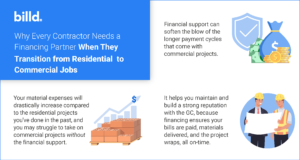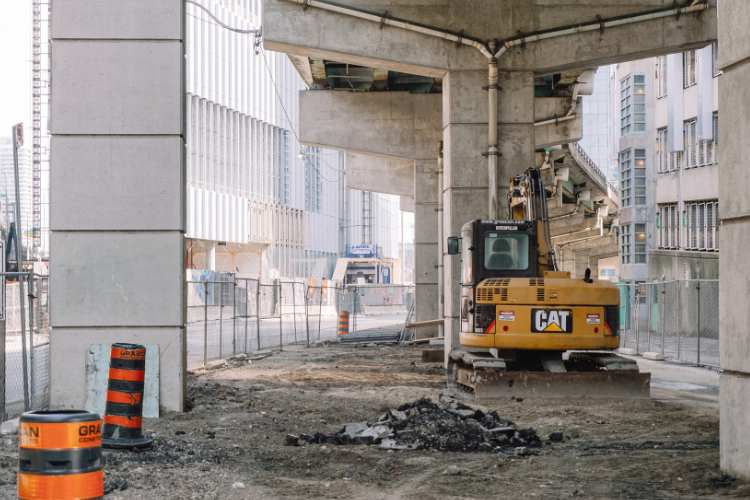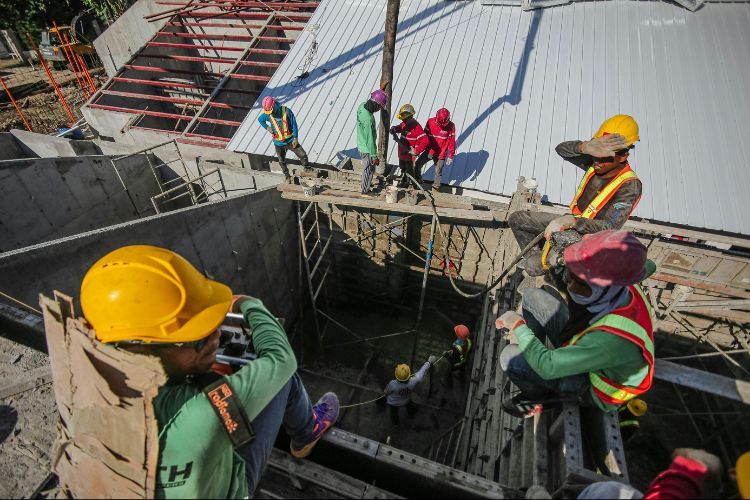Transitioning from residential construction to commercial construction projects is a goal for countless subcontractors. You can double, or even triple, your revenue by winning just one project. To help contractors prepare to make the switch, Billd has compiled ten key differences that you’ll need to be aware of, as well as helpful hints on how to prepare. By entering the commercial world of construction, you’re taking a huge step toward growing your business, and Billd is here to help make that transition as smooth as possible.
With that in mind, let’s dive into ten key differences you’ll be glad you knew about in advance as you transition from residential to commercial construction.
Table of Contents
- 1. Learning a New Bid Process
- 2. Getting Approval on Materials and Sticking to Specs
- Free Toolkit: Resources to Support Your Transition from Residential to Commercial Construction
- 3. Handling More Complex Building Code and Permit Requirements
- 4. Scheduling When You Have More Stakeholders Involved
- 5. Getting Familiar with New Contract Language
- 6. Preparing for Longer Payment Cycles
- 7. Making Much Larger Material Purchases
- 8. Understanding You May Earn Lower Profit, But Enjoy Higher Growth Potential
- 9. Preparing for Different Licensing and Insurance Requirements
- 10. Managing A Larger Administrative Workload
- Getting Equipped for a Successful Residential-to-Commercial Transition
1. Learning a New Bid Process
Making the jump from residential construction to commercial construction means that the way you find projects and bid on jobs changes entirely. Most of the commercial projects you bid for will have plans and specifications that are accessed electronically. Taking off projects electronically and putting together an estimate from that take-off is not something you do on residential projects, but is a skill you’ll need to master for landing commercial ones. Additionally, you’re now dealing with general contractors and industry experts who have high expectations and decades of experience. Homeowners, by contrast, have softer deadlines, minimal knowledge of your industry, and fewer regulations (if any) and specs.
How to Prepare: Consider using a construction software like Stack, an online tool to help contractors quickly and easily put together take-offs and detailed estimates.
Finding commercial jobs to bid on is relatively easy, thanks to commercial bidding websites, but winning your first job is hard. This is where the real heavy lifting comes into play. Expect to submit a lot of bids (could be up to 50) before you’re awarded your first project.
Since this is so crucial, we’ve compiled a list of tips for landing for your first commercial construction job:
- Focus on interior finish-outs – If they are in line with your skillset, this is a great way to get your foot in the door with a GC.
- Become a “sub to a sub” – Larger subcontractors often get tasked with small jobs and touch ups from the GC for work that they don’t want to do or feel the returns aren’t worth the investment. You can offer to take requests like this off their hands.
- Bid on public projects – The playing field is often more level with these projects, as the lowest bidder is sometimes awarded the project.
- Join your local contractor’s association – They will also post projects to bid.
2. Getting Approval on Materials and Sticking to Specs
So you’ve landed your first commercial project. What comes next? It’s important to know that your work won’t begin until the materials you plan to use have been submitted and approved; this is known as the submittal process, and it can be fairly rigorous.
You’ll have to review the plans and specifications (specs) and provide documentation on exactly what you’re installing. Architects review documentation or samples you provide and approve them for use on the project. If the product is not approved for use, you will be asked to resubmit on an approved product. Managing these documents and keeping track of what has been approved is important and will require additional time. If you install materials without approved submittals, you run the risk of having to remove them and reinstall with approved materials, all of which reflects poorly on you as the sub, and eats up time and money.
How to Prepare: Review the best practices of construction submittals and be sure to read up on the list of common problems and errors that contractors make with submittals, so that you can avoid them ahead of time.
Free Toolkit: Resources to Support Your Transition from Residential to Commercial Construction
3. Handling More Complex Building Code and Permit Requirements
Commercial projects are, generally, larger and more complex than residential construction ones. Codes and regulations for commercial projects are significantly different than those in residential, and they vary by region. Residential building codes are nothing short of strict, but be prepared that they go up a notch on commercial buildings. You’ll need to comply with the Americans with Disabilities Act, and there are additional requirements in the realm of fire safety and building exits (and that’s just the tip of the iceberg).
How to Prepare: Study up on the building codes and permits required for the commercial project you’re working on, and know how they’ll affect the cost of work. Be sure to train your employees on any relevant changes that apply to them in this arena. Hiring new talent with experience in commercial jobs can also be a tremendous help here.
4. Scheduling When You Have More Stakeholders Involved
The increased complexity of commercial projects goes beyond building codes. You’ll also contend with far more stakeholders. From the GC to the property owner, fellow subs, code officials, and architects, engineers, you’ll be reporting to more parties and will have to efficiently coordinate with each of them to keep the project timeline on track. For this reason, your expenses, materials, lead times, scheduling and dispatching have to be precisely planned.
How to Prepare: Take measures to reduce your lead times and let the GC know as soon as possible if material or other delays are causing you to not meet your expected schedule. Be ready to be on the job when the GC calls.
5. Getting Familiar with New Contract Language
Whether you’re a general contractor or a sub, you’ll find that commercial construction contracts are longer and have more legal jargon than residential contracts. Since these contracts provide the basis of how the work will be performed and how you’ll get paid, it’s especially important that you know what they say and equally as important, what they mean.
If a section of the contract is unclear, consult with a quality lawyer who is well versed in commercial construction contracts. If you can’t afford to have a lawyer review all of your contracts or even a portion of the contract, review them yourself and contact an attorney when you have specific questions about a clause.
How to Prepare: Remember, as a party to the contract, you have the right to negotiate. Ask for changes if the terms are unfair. The worst they can say is no. Identify when a change is a deal breaker and be ready to walk away if you have to.
6. Preparing for Longer Payment Cycles
According to a recent survey by Levelset and Fieldwire, it can take 83 days for subcontractors to receive payment on a commercial project. Having to wait that long for payment can cause cash flow problems for any contractor, large or small. If cash flow gets tight during a project, paying your suppliers could become challenging and stressful, and you may find yourself dipping into the payment from another project to fund this one. Or, you may end up slow-paying your supplier, potentially causing friction with that relationship.
How to Prepare: Before you make the transition to commercial work, put together a cash flow projection. This is a report that details all your cash inflows and outflows for a given period, such as monthly, quarterly or yearly. By building this out, you’ll be able to identify when you might have a shortage of cash and then plan for it with contractor financing options. Additionally, you should have a good understanding of how much cash is required to take on a new commercial project. This tool from Billd helps contractors estimate how much cash they need to take on a project, plus when they’ll break even on it.
7. Making Much Larger Material Purchases
Commercial projects are often large and require a substantial amount of materials to even get started, let alone complete. As discussed in number 6 above, slower payments will inevitably put stress on your cash flow, so it’s important to plan ahead and know how you’ll pay for these larger purchases. Start by having discussions with existing suppliers about larger purchases and see what kind of terms they’re willing to extend you.
How to Prepare: After you’ve started building your commercial portfolio with interior finish-outs and “sub-to-a-sub” jobs, take a look at project-based financing for the larger material purchases you may need to make. This is an excellent option for funding commercial building materials. A lender with a background in construction will pay your supplier for the materials upfront and extend to you up to 120-days to pay them back. That means you can leverage cash discounts (by paying in cash for materials) and simultaneously have ample time to pay for your materials. That’s why it pays to find a supplier who offers material financing through a partner like Billd.
8. Understanding You May Earn Lower Profit, But Enjoy Higher Growth Potential
The profit margins in residential construction are generally higher than in commercial construction. In 2017, the National Association of Home Builders said the residential profit margin was as high as 42% for home remodeling and 25% for new homes. In the same year, commercial construction companies reported gross margins of 10%.
But don’t let the numbers discourage you!
The good news is that most commercial contracts are going to be significantly larger than their residential counterparts. Large remodel and new construction projects can easily start at $1 million and go up from there. The truth is, you can make significantly more money when you move from residential to commercial construction.
How to Prepare: If you go in with the appropriate expectations and an understanding that margins are going to be thinner, you’ll be able to plan your finances accordingly.
9. Preparing for Different Licensing and Insurance Requirements
In some states, commercial and residential contractors are licensed differently. A company can work in both, but there are different requirements for each. Those differences usually include higher insurance and bond limits. Before you make the leap to commercial or public projects, do your research, and know what your insurance requirements are. Shop around for the coverages you’ll need and find the best price.
How to Prepare: Talk to your insurance company about what it would take to get a P&P Bond. P&P Bonds could cost you up to 2.5% of your project value, but they are required on many public projects. It’s important to note that you may not have bonding capacity, and that could mean you can’t bid on projects that require bonding.

10. Managing A Larger Administrative Workload
Even in this “paperless” age, commercial construction projects create a lot of paperwork, and that paperwork can differ from the residential forms and documents that your staff is used to managing.
Commercial document types that you may not have seen on a residential project include:
- Requests for Information (RFI)
- Submittals
- Certified payroll
- Lien management
- Construction notices
- Construction liens
You may need to look into hiring some administrative assistance to help you with the increased paperwork. You can also invest in construction management software to help you keep track of documentation on projects. This may allow you to do more work with the same administrative team you have now.
Tools to help contractors manage an increased administrative workload:
- Procore – For overall project management
- Smartsheet – For managing submittals
- Concept3D – Provides you with an interactive map of the location and building specs, as well as immersive virtual tours of the building that is under construction
- Raken – For efficient reporting, with branded daily reports from users such as field workers, foremen or superintendents
- SiteCapture – For taking job site and project photos, and collecting data for the construction, material delivery and quality inspection processes.
Getting Equipped for a Successful Residential-to-Commercial Transition
As you accumulate experience and network with GCs, the switch from residential to commercial may be slower than you were expecting. But with larger contracts and higher paychecks, it’s well worth the effort. By arming yourself with knowledge beforehand, you’ll be able to develop strategies to address each difference, and hopefully ensure that your transition will be a successful one.








